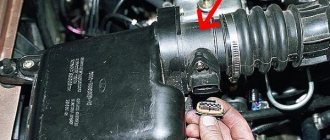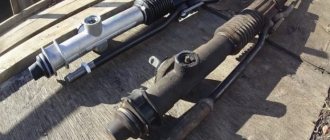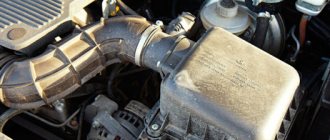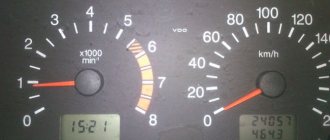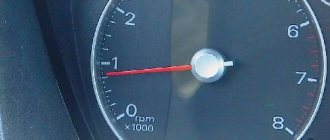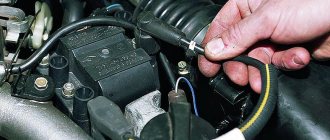Published: 01/28/2021
- What to do if there is no spark?
- Troubleshooting
- Checking for spark
- Causes of spark loss
- How to test ignition coils
- Signs of broken or dirty injectors
- About the purpose of the coil
- No spark on an injection engine or an engine with a carburetor: how to check
- The main reasons why there is no spark
- No spark? We are looking for reasons!
- Coil
- Possible reasons for absence
What to do if there is no spark?
If there is no spark, check for the presence of a “plus” terminal of the coil when the ignition key is turned on. This can be done using a multimeter, setting it to measure direct voltage (DC).
If there is voltage, the problem is related to the coil trigger circuit (crankshaft position sensor, ignition module, wires, etc.).
If there is no voltage on the coil, there is a problem in the power circuit (ignition key, wires, connections).
If voltage is being applied to the coil, the problem could be a bad high voltage output wire from the coil to the distributor, hairline cracks in the coil cap, or cracks or carbon tracks inside the distributor cap or on the runner.
Using the Scanner
If you have a scan tool, connect it to the vehicle's diagnostic connector and watch the RPM signal when you start the engine. No signal? The problem is poor operation of the ignition distributor signal sensor (on engines with a distributor), a malfunction of the distributor drive mechanism (usually for plastic gears), a malfunction of the ignition distributor (on engines without a distributor), a wiring malfunction (break, short circuit, oxidation of contacts).
If the Check Engine Light comes on, use a scan tool to read ignition-related trouble codes. Any codes related to the coil (P0351 − P0358) will require a coil test. Misfire codes indicate that the spark plugs and/or spark plug wires need to be checked.
Checking the ignition coil
The ignition coils in DIS (Distributorless Ignition System) ignition systems function in the same way as in conventional ignition systems, so the tests are essentially the same.
But symptoms caused by a weak or faulty coil will be limited to one or two cylinders in a DIS ignition system, rather than all cylinders in an engine with a distributor and one coil.
Most DIS starting problems are caused by a bad crankshaft position sensor. Many DIS systems use "idle spark", where one coil ignites two spark plugs that are placed opposite each other in firing order. Others, including newer coil-on-wire systems, have a separate coil for each spark plug.
Individual DIS coils are tested essentially the same as epoxy filled (square type). First disconnect all wires. Set the multimeter to resistance measurement mode in the lowest range. Connect the device to the primary terminals of the ignition coil and compare the resistance of the primary winding with the data in the specification (usually less than 2 ohms).
Then connect the multimeter to the secondary winding and compare the readings with the rating data (usually 6000–30,000 Ohms). If the readings are outside the specified range, the coil is faulty and needs to be replaced.
If measuring the DIS coil secondary resistance is difficult due to location, try disconnecting the spark plug wires and measuring the secondary resistance through the wire plugs rather than the coil terminals. Just remember to add a maximum of 8000 ohms of wire resistance to your readings.
How to save 20% fuel?
This thing really saves 10-30% on gasoline. You simply install this device on the fuel supply hose and...
My homemade adapter is used. Let's connect to the brains...* The loader used is this one - CombiLoader, this version is like this. I downloaded the firmware for myself, I’ll read why this firmware is cool. Maybe people saw it that way according to the version, I don’t know. Usually, when I repair a car, I use standard water and there are no more problems. And then all sorts of Sports, Economy and others - you won’t understand later that it* works so poorly. I'll show you the results.
I deceived you, unfortunately, I won’t show you how the problem was solved. And the problem was quite interesting. It seems that, based on the first signs, the crankshaft sensor was alive, one might say “conditionally alive”, because when the crankshaft rotated, the fuel pump turned on again and I, as it were, temporarily got rid of this problem. But, as it turned out later, the car had recently been repaired, the head was removed, and inexperienced mechanics laid a wire leading to the crankshaft position sensor near the exhaust manifold.
The wire melted and one of the wires shorted to the braid. For those who don’t know, there is a shielded cable in which two wires are laid. Surprisingly, the brain recognized the pulse in this position and turned on the actuator, that is, the fuel pump relay was turned on, but, accordingly, the engine control unit* was unable to calculate the position of the top dead center, or calculate the position of the pulses. I noticed it purely by chance (I was already freezing, I had no time for filming), just moving the wire near the crankshaft position sensor.
I took it off, checked the sensor - the sensor seemed to start* correctly. Pulling the wire, rotating the starter, the engine began to seize. At this point it became clear that the problem was with the wiring, and after looking carefully at the wire, I saw that it was burnt out. I cut out the damaged area, connected it - and the car started up perfectly and drove away*. It was already dark, I wanted to go home, so there was no time for filming. Nevertheless, I am reporting on the results and a little bit (about) my technique, which I talked about a little earlier in the video, about how to find a spark - the sensor can turn on the pump and at the same time not give a spark - a very interesting case came across. I think you'll take note.
Troubleshooting
Since trouble has affected you, you don’t need to rush headlong to the service center and pay unknown amounts of money for diagnostics and repairs. You can repair your car yourself and save a lot of money. Let's figure out why there is no spark from the ignition coil, and find out why it could disappear and how to solve this problem.
The first step is to inspect the coil very carefully for any mechanical damage, as well as various stains that could cause a loss of high voltage.
If there are stains, they should be wiped off with a dry cloth. Inspect all contacts and wires; they should not be wet or have any damage. After this, try to move the high-voltage wires and then start the car. If after such manipulations the car does not start, then you need to carry out more in-depth diagnostics.
You need to check the performance of the spark plugs. To make sure that the spark plugs are working correctly, you can do the following: you need to remove two high-voltage wires from the distributor cap and place them near the car engine at a distance of seven millimeters. So, if, when starting the starter, a blue spark appears at this distance, this means that the system is working, and if its color is not blue or is not there at all, then you need to repair it or replace it with a new one.
The coil is checked using the same method as spark plugs. We take the wire going from it to the distributor and bring it to the engine ground, after which we start the car’s ignition. If you don't see a spark, the real reason the car is stopping is the inductor. Next you need to check it with an ohmmeter. In this way we will check for an open circuit on the primary and secondary windings. If there is no gap, then the ohmmeter will show three Ohms on the primary and seven thousand Ohms on the secondary windings. If the data is less, you should replace the ignition coil with a new one.
When diagnosing, it is also advisable to check each wiring and contact. It is necessary to inspect both the wires and their insulation; perhaps it is in these areas that the fault is “settled”. You need to untangle the wires if they are tangled by laying them out correctly. Using an ammeter, you need to check the presence of current in the circuit and its strength. To do this, you need to connect the distributor wires and start the car ignition.
In the case when the current strength is much less than the standard (it is indicated for each car separately in the PTS), it means there is a break in the coil, which could appear as a result of a short circuit. Very often the ignition coil sparks and thus breaks down when the ignition is on and the engine is off. As a result, the insulation on the wires begins to heat up, which eventually cracks and crumbles. The moment the bare wires come into contact, a short circuit occurs.
So, when the true problem of breakdown is identified, it needs to be reinstalled or purchased a new one and replaced. Those mechanisms that have minor cracks and scratches are subject to repair. Such damage can be removed by stripping or gluing with a special substance. The coil is replaced only with the same one, with the same characteristics.
When connecting a new coil you need to be very careful and careful
It is very important not to mix up the wires. Otherwise, the wires will be connected incorrectly, which will cause them to heat up and cause a short circuit.
To prevent premature breakdowns from happening to your car, monitor its operation and its component mechanisms. Otherwise, you may pay for your negligence. Good luck with your car repair.
Checking the control unit
If the VAZ 2114 does not have a spark in cylinders 1 and 4, and the spark plugs, armored wires and ignition module are working properly, then the last reason remains - a breakdown in the electronic control unit. This is easy to check - just connect to the unit using a light bulb with two wires. If the light blinks periodically, then the unit is working; if not, then the problem lies with it.
In this case, you should disconnect the unit, open its case and remove the board, then carefully inspect it. Very often the breakdown of this device is the burnout of the transistors (they look like the largest electronic components with three legs). If one of them looks burnt, it should be replaced.
For this you will need:
- tester;
- soldering station or hair dryer;
- tweezers (preferably with ceramic tips);
- low-melting solder.
First you need to check the transistor using a multimeter. If it shows no signal, then the element will need to be unsoldered, and in its place soldered a new one - similar or similar in its properties (transistors can be purchased in stores for radio amateurs or ordered from China, for example, from Ali. In the latter case, they will cost less than 15 rubles).
Transistors should be desoldered and soldered using a soldering station or a single hair dryer, since they are made in chip design
If soldering is carried out with a soldering iron, then it should be done extremely carefully and using low-melting solders
After the transistor is replaced, the electronic unit will need to be assembled and installed in place, and then try to start the car. If all 4 cylinders work properly, then the problem has been resolved; if not, then you should continue your search and check all other electronic components of the device with a tester. If additional parts are found to be faulty, they should also be re-soldered.
If such a check does not show results or the task of finding burnt elements turns out to be too difficult, you will need to replace the unit with a new one - similar or similar in characteristics.
True, if an immobilizer is installed on the car, then the burnt-out unit should be replaced exclusively with exactly the same one (installing even a close analogue will lead to the fact that the car simply will not start).
Checking for spark
Let's say your fuel-injected car has stopped responding to the ignition key and refuses to start. It is quite irrational to immediately complain about a malfunction in the ignition system. First of all, you need to make sure that it is the spark that has disappeared and not something else that has broken. To check spark plugs for the presence of the coveted “light”, you can resort to several procedures at once. Perhaps the most effective and simple ones are the following:
- The first method is a mass test. To implement it, you need to turn off the ignition, unscrew each spark plug in turn and, placing its body against ground (the metal body of the engine), try to start the engine;
- The second method is checking with a multimeter or a tester based on a piezoelectric element. This diagnostic option is quite similar to the method described above, except that the spark plug is applied not to ground, but to the contacts of the tester or multimeter. However, in this case there is no need to “turn” the starter; the spark must come from the devices themselves.
If, as a result of the above-mentioned testing methods, sparking on the spark plug is not detected, or there is a spark, but weak (dimmed, dim, dull), it is necessary to identify the cause of the malfunction. Do not forget that operating a car with a poorly functioning ignition negatively affects engine performance and significantly reduces its service life.
VAZ 2114 does not start reasons
Factors that influence indirectly or directly on the formation of causes are varied and are expressed mainly by signs of malfunctions of two machine systems:
- fuel (manifests itself in the fact that 2114 does not start, stalls while driving and does not start);
- ignition system electrician.
In addition to common reasons, there are those that require expensive repairs, these include:
- engine malfunction;
- broken timing belt.
Repairing a carburetor type is cheaper and easier than an injection type.
VAZ 2114 injection type 8 valves does not start due to:
- clogged injectors;
- refueling with low-quality gasoline;
- decreasing the pressure level in the ramp.
Causes of spark loss
Before checking the spark on your injection or carburetor engine, you need to figure out why this spark may disappear and where you should look first, trying not to damage the engine itself.
Depending on the specific type of internal combustion engine used in a car, there are several main factors that cause the lack of a high-quality working spark in the spark plugs. But often this is directly related to:
- discharged battery;
- damaged or failed spark plugs;
- filling spark plugs with fuel or oil;
- faulty module, coil or switch;
- poor contact of the insulation itself or damage to some high-voltage wires;
- faulty crankshaft position sensor;
- a failed distributor;
- poor quality of contact with ground;
- problems directly in the low voltage circuit itself;
- faulty control electronic unit.
Experienced motorists advise starting the check with the most banal, but at the same time quite common reason. Namely from the battery. The battery could simply be discharged, making it impossible to start the engine.
If, when you turn the key in the ignition, you see the icons on the dashboard shining very dimly, then the battery is probably dead. Solving such a problem is not difficult. If the battery is drained, it will need to be charged or completely replaced with a new battery.
Also, a problem with the operation of the system may lie in terminals that are oxidized or corroded. It is necessary to clean them, tighten them tightly and treat them with high-quality graphite lubricant. This treatment will prevent re-oxidation.
Reason #5 – Burnout of transistors in the ECU
The lack of a spark can also be explained by broken transistors in the VAZ electronic control unit. To detect faulty elements, you will need to dismantle the controller and also remove the protective cover. To check the functionality of the transistors, you will need to use a multimeter. The device is put into dialing mode, then both contacts of the transistor, as well as ground, are checked. If a short circuit is detected, the multimeter will emit a corresponding squeak, and the broken transistor must be replaced with a similar serviceable element.
How to test ignition coils
Method #1: Spark Test the Ignition Coil
Testing the ignition coil with a spark
Stop the engine and open the hood. Depending on the make of the car, the coils may be located in different places. On engines without an ignition distributor, the spark plugs are connected directly to the coils. The surest way to find the coils is to follow the wires that go from the ignition distributor in the opposite direction. Protect exposed skin and eyes and only use tools with insulated handles.
Disconnect one high voltage wire from the spark plug. A separate cable leads to each candle. If you have stopped the engine recently, it will likely be very hot. To avoid injuries and burns, wait 10-20 minutes and start working.
Remove the spark plug using a spark plug socket. Do this carefully, not allowing debris to get into the candle hole. If dirt or debris gets into the spark plug hole, it can damage the engine. And removing debris from the cylinder is a rather complicated operation. So be extremely careful at this point.
Reconnect the previously pulled wire back to the spark plug. The spark plug must be connected to the ignition distributor, but not screwed into the engine. Use only insulated-handled pliers to hold the candle to avoid electrocution.
Touch the threaded side of the spark plug to bare metal. Touch the threaded part of the spark plug to a bare area of your car. This could be the engine or an area that is missing paint.
Ask a helper or friend to turn on the ignition. When the ignition is turned on, all electrical systems of the car begin to work, and if the ignition coil is working properly, then voltage will be supplied to the spark plug.
Make sure you see blue sparks flying. If you don't see a blue spark, then the problem is obvious. Your coils are not functioning and need to be replaced. If the spark is orange, this means that insufficient voltage is being supplied to the spark plug. The reasons may be: low current, poor contact or damage to the coil.
Reinstall the spark plug and reconnect the wire. Turn off the ignition and reassemble in reverse order.
Read only on vse-provse.com Installing a car alarm with your own hands
This is the first way to check the ignition coil yourself. Be careful when working with voltage and follow all safety regulations.
Method # 2. Testing ignition coils by measuring resistance
We test the ignition coils by measuring the resistance.
We remove the coil from the car. This is the surest way to ensure that the coil is working properly. To do this, you need a device for measuring electrical resistance - an ohmmeter. Using an ohmmeter, you can accurately determine the current condition of the ignition coil. In order to remove the ignition coil, you need to: disconnect the wires from the ignition distributor, and unscrew the fastenings of the coil itself with a wrench. This must be done with the ignition off.
The specifications for your ignition coil model are required. Each car has its own coil characteristics. If your measurement showed different indicators than those indicated in the specifications, then your coil probably requires repair or replacement.
Touch the ohmmeter probes to the contacts of the primary winding of the coil. Touch the two side contacts at the same time. On the distributor side, the coil has three contacts: one in the center and two on the sides. Turn on the ohmmeter and measure the readings.
We measure the resistance value of the secondary winding. Touch the probes to the central contact and one of the side ones.
Compare your performance with factory specifications. The ignition coil is very sensitive. If the readings differ from the factory values, the coil should be replaced, as it is damaged and does not work correctly.
The resistance of the primary winding should be in the range of 0.7-1.7 Ohms. And the secondary is in the range from 8-15 kOhm. These are the two easiest ways to check the ignition coil yourself and at home. To check the coil you will need:
- Wrenches, in particular spark plug pullers
- Screwdriver
- Insulated pliers
- Candles
- Ignition
- Ohmmeter or multimeter
Causes of sparking problems
If there is no spark on the injector, and not, for example, on a carburetor or gear motor, you will have to try to identify the reasons for its loss. This is due to the fact that there are slightly more factors influencing spark formation in injection systems and they look more multifaceted. If we summarize the general list of possible causes of the problem, then it is worth highlighting the following most common ones:
- The spark plug or spark plugs are flooded with fuel - there is either no spark or very weak, the spark plugs themselves are wet;
- The spark plug or spark plugs are faulty - there is no spark at all, deposits on the contacts are usually black or white;
- The crankshaft sensor, ignition module, ignition coil, switch or distributor is faulty - there is no spark at all, the engine shows no signs of “life”, the injector does not work correctly;
- High-voltage wires have broken through or there has been a loss of contacts - one or two spark plugs do not work, the rest are fully operational;
- The injector electronics (ECU or wires) are faulty - the unit does not work correctly, there is no spark at all spark plugs;
- The injector nozzles are clogged - there is no spark at the spark plugs of specific cylinders, the injector is not working correctly.
Please note that for a complete and most accurate diagnosis, it is necessary to carry out several procedures at once:
- Naturally, check for a spark;
- Assess for the presence of the symptoms described above;
- Check for relevant errors on the dashboard or on-board computer screen;
- Check the potentially faulty unit (disassembly, cleaning, diagnostics with a multimeter, etc.).
If, based on the results of all diagnostic procedures, the problem is not identified, then, most likely, a visit to the service station cannot be avoided. Otherwise, it is quite acceptable to carry out repairs yourself, of course, if you have the proper skills, abilities and tools.
Signs of broken or dirty injectors
Diagnosing the operation of a car engine is a rather complex process, as it requires accuracy. It often happens that with the same symptoms, the causes of the malfunction can be completely different.
For example, increased fuel consumption and poor engine starting can be caused by both dirty, broken injectors and bad spark plugs. Therefore, it is better to once again make sure that the diagnosis is correct.
The most common symptoms of faulty fuel injectors are the following:
- a sharp increase in fuel consumption;
- loss of dynamics, drop in engine speed;
- problems with ignition, engine starting;
- fuel leaks accompanied by a strong smell of gasoline;
- Frequent engine vibrations when changing gears, slowing down, jerking while driving.
Fuel consumption jump
A significant increase in gasoline consumption during vehicle operation often indicates a clogged fuel injector. The quality of the air-fuel mixture formation process can be greatly affected even with minor contamination, since the injector nozzle has a very small diameter.
As a result, a larger volume of gasoline burns inside the exhaust manifold. Because of this, the dynamic characteristics of the car are reduced, the load on the ignition coil, high-voltage wires, and spark plugs increases.
RPM drop
In cases where too much fuel is sprayed inside the cylinder, the engine speed is “flooded” with gasoline. Because of this, the dynamics of the car during acceleration are significantly reduced. In addition, with a constant load while the machine is moving, the engine speed will vary significantly. Normally, they should remain at a stable level.
Fuel leak
If the fuel injector housing is damaged, gasoline begins to leak out of it. As a result, the fuel simply does not reach the injector. Leakage often occurs through a defective device seal, which often cracks over time. When checking the injector, traces of leaks can be found on the nearest fuel rail.
Along with fuel leaks, a persistent smell of gasoline often appears. On the other hand, this situation occurs when a stuck injector is left open or damaged
Under such circumstances, it is important to find the real cause of the odor.
Problems with ignition and starting
If the injector nozzle is clogged, a sufficient amount of fuel does not flow into the cylinder, so the power unit will misfire while the car is moving. This will clearly manifest itself as a certain pause when pressing the accelerator pedal. If the proportions of the air-fuel mixture are violated, the power unit is susceptible to overheating.
Frequent vibrations
Injector malfunctions lead to interruptions in the ignition process of the air-fuel mixture inside the cylinders. Therefore, while driving, the engine will vibrate and tremble. This occurs due to interruptions in the operation of one or more cylinders.
In some cases, this problem occurs due to clogged fuel lines or faulty ECU sensors.
Fuel pressure control
The regulator consists of a membrane and a spring. During a malfunction, it may hang open and because of this, the fuel pressure in the system will not be enough for the engine to operate correctly and to start it, so the engine stalls when cold.
To check the functionality of the valve, it is not enough to simply remove the hose from the pump and see how strong the gasoline pressure is. Diagnostics must be carried out with a pressure gauge. There is a special connector for it on the fuel rail. We connect the device and try to start the engine. If the pressure in the system is below 3.6-4.0 atm, this is an indicator of a problem in the fuel supply system.
It is better to replace the pressure regulator in a special service, but if you want to do this process yourself, then follow the instructions:
- Disconnect the battery terminal;
- Remove the hose from the vacuum brake booster;
- Drain gasoline from the system;
- After this, start disconnecting the fuel rail from the pressure regulator.
- Replace and install everything in place.
If all work is performed correctly, the fault in this part of the system will be eliminated.
About the purpose of the coil
To ignite the combustible mixture of gasoline and air compressed in the working area of the cylinder, a high voltage is required on the spark plug. Its value exceeds 30 thousand volts. The on-board voltage of the car in most cases is 12 Volts. The ignition coil is designed to obtain the required value.
Photo of ignition coil VAZ 2101-2107
This component of the car must be given due attention; if other systems fail, the car can independently reach the parking lot or service center. In the case where there is no spark, this is impossible to do.
You will have to look for a tow truck or call a tow truck.
Bringing the car back to life
As for why a spark disappears, everything is probably very clear. Now, it would not be amiss to consider the order of her return. The reality is that in most cases, getting the spark back is a simple matter and just involves carefully checking the broken car. To be more precise, to normalize sparking it is required:
- Firstly, check the spark on the injector using the method described above, make sure that it has disappeared, and, at least indirectly, try to determine the cause of the malfunction;
- Next, it is enough to assess the current circumstances and act based on them. As typical situations, we suggest considering solutions to the following problems:
- the spark plug is wet, the presence and strength of the spark are unimportant, the carbon deposits are correct (brick color) - wipe the part and screw it back in;
- the spark plug is wet (not always) and the carbon deposits are incorrect (white or black) - clean, dry the part and try to start the engine, if there is no result, change the spark plug and deal with problems in the fuel system (cleaning the injector, checking the ECU, etc.);
- the spark plug is wet, there is no spark at all, the color of the soot is not important - we try to change the part, if there is no result, we check the ignition system and the operation of the injector.
In principle, in theory there are no particular difficulties in repairs of this kind. Despite this, it often causes difficulties in implementation for inexperienced motorists. To solve these, you need to act in the order described above, but if something doesn’t work out, it’s better to turn to professionals at a service station. This approach to repairs will not only save time, but also guarantee trouble-free operation of the car in the future.
Perhaps this concludes the most important information on today’s issue. We hope that the material presented was useful to you and provided answers to your questions. Good luck in operating and maintaining your car!
No spark on an injection engine or an engine with a carburetor: how to check
Checking the spark is possible using several methods: to ground, using a multimeter, or a special tester on a piezoelectric element. The first method is the simplest. The body of the unscrewed spark plug is brought to the metal (usually the engine cylinder block), after which the engine is cranked by the starter and the presence of a spark is analyzed.
Please note that this verification method cannot be used when diagnosing injection cars. The fact is that a car with an injector has an ECU and other electrical equipment that is quite sensitive and can be damaged
The second method allows you to better assess the condition of the spark plug, identify breakdown, etc. The use of a special tester is a method of checking the spark on injector cars, reminiscent in its principle of checking by analyzing the spark breakdown to ground (the first method). In this case, the risk of burning the control unit is minimized. Now let's talk about how to check the spark on a fuel-injected engine.
As mentioned above, a special spark arrester device is used to check the spark on the injector. The presence of this solution during diagnostics allows you to accurately localize the problem area, since the ignition spark may not be on the spark plug, on the distributor or on the coil. Also, there may be no spark in only one, several or all cylinders of the engine.
A complete lack of sparking indicates possible problems with the controller, ignition module, coil or center wire. Diagnostics should begin by checking the fuses. Then you should evaluate the condition of the ground contact, and also check the high-voltage wires.
If there is no spark at the ignition coil, then the functionality of the high voltage wire should be checked. The specified wire must be checked for insulation integrity, have no breakdowns, burnt areas, etc. Detection of any defects is grounds for its replacement.
Also, in the process of diagnosing the ignition system, you should inspect the spark plugs. This must be done if electricity reaches the candles. On carburetor cars, it is enough to remove the spark plug wire, and then bring it closer to a metal surface (for example, a car body) by half a centimeter. Then you need to turn the starter and make sure that there is a spark running between the wire and the metal surface. The spark itself should also have a certain intensity, be white with a slight bluish tint. If no deviations are noticed, then the spark plugs are working. The reason that there is no spark at the spark plug may be the ignition coil.
If you notice problems with the spark plugs, then you need to pay attention to the spark plug contacts. These contacts must be free of contamination
Let us add that if deviations from the norm are noticed, it is optimal to immediately replace the spark plugs. Failure to do so will indicate the need to clean the contacts.
Low voltage circuit
Using a 12V lamp, you can check the low voltage circuit. The lamp must be connected with the first contact to the low voltage terminal, and the second to the car body. Next, you need to close the distributor contacts and start the ignition. If the circuit is OK, the lamp will light when the contacts open and go out when the contacts close.
If the lamp does not light up when the contacts are opened, this means that the problem is in the low voltage wiring or in the ignition coil, or rather, in its winding.
There is a special offer on our website. You can get a free consultation with our corporate lawyer by simply submitting your question in the form below.
The main reasons why there is no spark
- problem with spark plugs (flooded or faulty);
- breakdown of high-voltage wires or loss of contact;
- the reason is the crankshaft sensor (requires checking with a multimeter);
- malfunction in the ignition module;
- failure of the ignition coil;
- problem in the switch;
- Distributor malfunction (burned contacts, loss of clearance);
- poor ground wire contact;
- failure or malfunction of the ECU;
Diagram of the engine control system (ECM) VAZ-2113, 2114 and 2115
- controller;
- – block of the ignition system harness to the ABS cabin group harness;
- – diagnostic block;
- – immobilizer warning sensor (APS);
- – immobilizer control unit (APS);
- - ignition coil;
- - spark plug;
- – nozzles;
- – electric fuel pump;
- – block of the ignition system harness to the electric fuel pump harness;
- – block of the fuel level sensor harness to the ignition system harness;
- – block of the ignition system harness to the injector harness;
- – block of the injector harness to the ignition system harness;
- - speed sensor;
- – idle speed regulator;
- – throttle position sensor;
- – coolant temperature sensor;
- – mass air flow sensor;
- – camshaft position sensor (phases);
- – oxygen sensor;
- – crankshaft position sensor;
- - knock sensor;
- – solenoid valve for purge the adsorber;
- – block of the ignition system harness to the instrument panel harness;
- – controller power supply fuse;
- – ignition relay;
- – ignition relay fuse;
- – fuse for the power supply circuit of the electric fuel pump;
- – electric fuel pump relay;
- – electric fan relay;
- – block of the ignition system harness to the air conditioner harness;
- – pads of the ignition system harness to the front harness;
- – electric fan of the cooling system;
- – block of the instrument panel harness to the ignition system harness;
- – ignition switch;
- – instrument cluster;
- – on-board control system unit;
- - starter relay;
- – mounting block;
No spark? We are looking for reasons!
In personal practice, I had several cases that were accompanied by a loss of spark, and below I will cite them and talk about each in more detail.
Again, I will make a reservation that this is not a complete list of all the problems that can cause it, but I will try to list most of them. For experienced owners, you can supplement your thoughts by
One of the spark plugs is faulty
If, when checking a spark plug, a spark does not appear between the electrodes, then the first thing to do is check the spark plug itself. It is possible that this was the cause of this problem.
Take a working spark plug (it’s better to always carry a spare one with you) and crank it a little with the starter, looking at the performance of the spark plug. If a spark appears, great; if not, you should look for the cause further.
Also, you can see the problems that cause the spark to disappear here: https://atlib.ru/blog/164-net-iskry
Failure of high-voltage spark plug wires or the central wire of the ignition coil
If there is no spark on any one cylinder, then try swapping the high-voltage wires. If after this the operation of the previous cylinder was restored, but the other cylinder, on the contrary, stopped working, this indicates a failure of the spark plug wire.
If a spark does not reach any of the VAZ 2106 spark plugs, then you should check the integrity and functionality of the central wire, in a similar way as in the last paragraph. Also, you should just try to stick the wire harder into the coil and the distributor cover, maybe the wire has just jumped out a little in one of these places and there is no necessary contact.
The contacts in the distributor are burnt or completely out of order
Open the distributor cover and carefully inspect the contacts. They could burn out and cause the spark to disappear. Also, check them for integrity.
And one more important point: with the distributor cover open, turn the starter and see if the contacts open? If not, you need to adjust the gap between the contacts.
If you are convinced that everything is fine at this stage, then you should pay attention to the next element
Malfunction of the ignition coil of VAZ 2106
If there is no spark even at the contacts, then there is a high probability that it is the ignition coil that has burned out. You can check it either with an ohmmeter, measuring the resistance, or by installing a new one and see if that fixes the problem!
Failure of the switch or hall sensor
This item applies to owners of a VAZ 2106 with electronic ignition. If there is no spark, then these two elements can cause this disaster. It is necessary to diagnose the malfunction of these parts and replace them with new ones if necessary.
If you have a BSC installed on your VAZ 2106, then you can carry a hall sensor with you in reserve, which is the most common cause of malfunction. Or, as a last resort, do as I did, carefully fold the old contact ignition kit and let it lie in the trunk. It doesn’t take up much space, but somewhere on the road it can really help you out if one of the BSZ elements burns out!
Electrical faults
Most of the problems lie here, so we’ll look at each option in detail here:
Nothing happens when I turn the key
On a VAZ 2114, this usually indicates a violation in the ignition switch - starter line, but one of the reasons for the breakdown “for blondes” is a dead battery, do not forget about it (checked with a voltmeter: it should be at least 11.8 V - and with a hydrometer, if the battery is serviceable : at least 1.22 in each jar).
Let's move on. The cause of such a malfunction may be a breakdown of the ignition switch cylinder, and the injector has nothing to do with it. If, when turning the key, new sensations arise (something catches, turning has become easier or, conversely, more difficult), that’s the problem.
Under the panel, approximately above the clutch, there are two relays: ignition switch and starter release. The reason may be a malfunction of one of them. They are checked according to the manual by a good electrician or replaced with a known working one.
Starter. Often the cause may be a jammed “retractor”. If you are standing in a field, you should try hitting it with something heavy like a large key (without fanaticism) - it may help. If the car is parked in a garage, you should remove the starter and try to start it directly from the battery.
To do this, press the housing to the zero terminal of the battery, install the wire with the alligator clip on the positive terminal of the battery and bring it to the positive of the retractor. If the starter tries to jump out of your hands, everything is fine (be careful, it is not recommended to carry out this procedure without basic knowledge of safety precautions and an assistant!).
If there is no reaction, the problem is in the retractor. If the relay buzzes, but the starter does not turn, the problem is in the brushes. If the starter makes a terrible sound, but does not turn, the problem is in the bendix.
If the starter turns, replace the battery and check the power supply to the chips that are connected to the starter (with an assistant, one turns the key, the other measures it with a multimeter).
Also pay attention to the ground wire that goes to the battery. If there are breaks in the wiring at the point of contact with the body or at the terminal, it must be replaced. It is also worth disconnecting the wire from the body and thoroughly cleaning it with a metal brush. The reason for the failure to start may be simple oxidation.
The starter turns, but the car does not start
This is the most common situation in the case of the VAZ 2114. The procedure for solving it must begin with answering the question of whether there is a spark. To do this, take an assistant, unscrew one spark plug, put an armor wire on it and very carefully (avoid touching live parts, hold the insulated part of the wire) apply the spark plug to the cylinder head cover. While the assistant turns the engine, watch the behavior of the spark plug. If there is no spark, you need to look for it.
If there's no spark
The ignition module is one of the key problems of the VAZ 2114 on the injector. It breaks often and sometimes a new one comes with a defect. You can read more about checking the ignition module in other material on our website. Please note that the problem may also lie in the chip that is connected to the module. The presence of power on it must also be checked.
DPCV is another reason why there may be no spark. Since this sensor monitors the firing phases of the cylinders, it is one of the key elements of the ignition system. Note that the probability of its failure is lower than that of the ignition module. It is checked by an electrician using an oscilloscope; garage methods do not provide an accurate assessment of the condition of the sensor (only replacement with a guaranteed working one).
ECU. “January” is a relatively reliable injector, but the “brains” can also malfunction from time to time. Often the problem with them is identified by a violation of the injection phases: for example, a spark is supplied only to cylinders 2 and 4, or only to cylinders 1 and 3. Sometimes the issue can be resolved by simply cleaning the contacts on the ECU chip; it is also subject to oxidation, which causes signal loss.
If there's a spark
Not often, but this problem does happen. By all indications, the car should start (gasoline splashes into the ramp, the starter turns, there is a spark), but the engine does not catch. There are also pitfalls here.
Injectors. In most cases, the problem is in them; it is worth taking the car for diagnostics and cleaning it with ultrasound. If trouble strikes you on the road, pay attention to the candles. If the injector supplies the mixture, they must be filled with gasoline; if the spark plugs are dry, the probability of an injector malfunction is high. However, keep in mind that injectors rarely fail suddenly and all at once. As a rule, the engine should start running before the car stops starting.
Poor quality gasoline. It is assumed that a serviceable engine should start almost on water, unless it runs poorly. In reality this is nonsense. There are enough examples of “dead” engines after refueling (both at “Uncle Ashot” and at completely official gas stations of well-known brands). Keep this in mind. If the car stops gripping immediately or a short time after refueling, you should not discount this option. The solution is to drain the gasoline and add another.
Lack of required pressure in the ramp. Here we return to problems with the fuel system. Perhaps the problem is the pump or problems with the TPS (unlikely). If you have January 7.2, the cause may be a malfunction of the mass air flow sensor. Unlike January 5.1, here this sensor is polled at startup and, if there is an error, the ECU may prevent the engine from starting.
Finally, we note that the reasons for non-starting in the presence of gasoline and spark may include the following:
- the phases are incorrectly set when replacing the timing belt, as well as its breakage or rotation - it’s worth checking;
- due to overheating, the cylinder head “started”;
- uneven compression in the cylinders, “stacking” of the rings.
Unplanted VAZ 2114 is a common situation, and there are many reasons that cause it. Therefore, it is worth approaching this issue fully armed.
Coil
In the case of the coil, it can be characterized as a fairly reliable and durable element of the ignition system. It rarely fails and causes trouble for the car owner. But sometimes problems appear and need to be fixed.
Most often, problems with the coil are caused by damage to the winding itself. If this happens, a breakdown occurs in the insulation, which can cause a short circuit that is dangerous for injection engines.
Another reason for damage to the coil is considered to be overload caused by malfunctioning spark plugs or damage to the high-voltage wiring (high-voltage wires).
Before you start checking the spark on the coil, be sure to make sure that the room where the diagnostic work is being carried out is dry. You can do the test yourself, and no special devices or professional equipment are required.
Diagnostics is carried out according to a standard scheme, which involves performing several sequential procedures:
Thoroughly clean the distributor cover from accumulated dirt. Only after this can it be opened and removed; After turning the engine crankshaft, it is necessary to close the distributor contacts; The ignition is turned on; The high-voltage wire coming from the distributor is brought to the ground of the car
It is important to ensure a distance of 5 mm; To increase the accuracy of the test, it is periodically necessary to manually open the distributor contacts.
If the coil is in good condition, during this test you will see a bright, fairly powerful white-blue spark.
When a spark appears, but it is quite weak and unstable, and does not form every time the contacts are closed, such a coil is no longer suitable for further use and must be replaced. In the vast majority of cases, it is impossible to repair the coil.
When installing a new element, do not forget about the importance of observing polarity. If you ignore this point, the coil will break again
If you contact a service center, they can check the coil on a special professional stand. Its advantage is that such diagnostics allows you to test the coil to determine its performance in different modes. But still, almost every motorist can independently figure out how to correctly check the spark on his injection type engine by diagnosing the installed ignition coil.
Fuel system problems
Lada Kalina Hatchback MyLittleFriend Kalinich Logbook Floating speed or Replacing the idle air control
Among the elements of the fuel system, the following factors influence engine starting:
- presence of gasoline in the tank;
- the integrity of the fuel lines under the “belly” of the car;
- cleanliness of the filters: coarse cleaning (located in the tank) and fine cleaning (located under the car, to the right of the spare wheel compartment).
Also included in this category are electrical components that are directly related to the fuel supply. This is an electric fuel pump and a fuel pump relay.
Before checking other methods, you must be completely sure that the VAZ 2114 with an injector is filled. “Yes, there are still five liters there” according to the indicator on the tidy or “I filled it up yesterday, I couldn’t spend that much” are not suitable. The gauge may be lying, and there may be leaks in the tank or fuel lines. Carefully check the car for fuel leaks; just in case, fill in 5-7 liters of gasoline from a canister.
The mesh in the tank rarely gets clogged, leave this option for last, but it’s worth trying to change the fine filter if electrical problems are ruled out.
The operation of the fuel pump is checked by ear (after turning the key, its operation should be heard; if not, the pump has “died”, or the pump relay, or a wiring break). According to the manual, you need to connect a pressure gauge to the fuel system. If the pressure does not stay within 2-2.5 atm, the VAZ 2114 will not catch due to insufficient fuel pressure.
Possible reasons for absence
Most modern cars are equipped with many sensors. They make the life of the car owner easier and complicate repairs. In the electronics responsible for the operation of an injection engine, there are several sensors responsible for the spark formation process. But the reasons that there is no spark (VAZ-2110, injector, 8 valves) may also lie in other components. There are several types of possible breakdowns. The first includes various problems in the car’s fuel system. This includes malfunctions in which fuel cannot enter the cylinders or the supply is interrupted.
If there is no spark (VAZ-2110, injector, 8 valves), then this may be due to the fuel system. Often the pump relay or the submersible element itself fails. The test is performed by ear.
Then there are problems related to the electrical part. These are some of the most common faults. In case of such breakdowns, no electric discharge reaches the spark plug. Naturally, the mixture will not be set on fire. Global problems include complete engine failure and timing belt breakage. It is not worth dwelling on these malfunctions in detail.
The first problem is that the starter turns, but does not engage
Let's consider the following situation when the VAZ-2114 does not start, but the starter continues to turn. You should also take into account the nuance that the starter still does not engage. The mechanism of the problem is as follows:
- the key is inserted into the ignition;
- the fuel pump pumped up the fuel mixture;
- during the ignition startup process, the starter turns in idle mode (experts call this process “the starter does not catch”).
Experienced motorists note that a similar situation occurs in VAZs with high mileage, so we can talk about wear of either the starter itself or its parts. So, most often the overrunning clutch or “Bendix” suffers; the main element here is the gear. It is this overrunning clutch gear that causes a lot of trouble, because its teeth are often subject to wear. The mechanism of the malfunction appears as follows:
- the driver turns the key;
- the starter starts to spin;
- The overrunning clutch gear cannot engage the engine due to tooth wear.
Even in the starter, its gearbox may fail. This problem is less common than the previous one. This gearbox includes several types of gears, which are also subject to wear due to the long life of the vehicle. There are five gears in total:
- one small;
- three satellite gears;
- one large one, attached directly to the gearbox housing and engaged with the satellites.
Even an experienced specialist will not immediately say in which of the named parts the gear teeth have worn out. To do this, you will have to remove the starter and disassemble it to inspect all the components.


